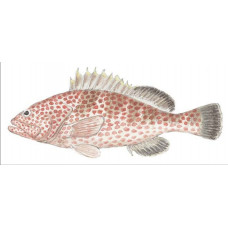Latin name
Epinephelus guttatus
Other names
Trawberry grouper, speckled hind; French: mérou couronné; Spanish: mero colorado, tofia.
Identification
Like all, grouper has a strong body and a large mouth. In appearance, it is very similar to the large mouth, although slightly more reddish-brown, with dark reddish-brown spots on top and pure red spots on the bottom against a whitish background. It differs from the rock hind by the absence of spots on the tail and dorsal fin and dark spots on the back and tail. The outer edges of the soft dorsal, caudal, and anal fins are blackish, sometimes with a white border. It may pale or darken to blend in with its surroundings.
Distribution
In the western Atlantic Ocean, red hind are found from North Carolina and Bermuda southward to the Bahamas, the southern Gulf of Mexico, and to Brazil. They are common in the Caribbean, rare in the Bahamas and Florida, and rare north of Florida.
Habitat
One of the most common grouper in the West Indies, inhabiting shallow coastal reefs and rocky bottoms at depths of 10 to 160 feet. In Florida and the Bahamas, they are usually found in quieter, deeper waters. Red hind are solitary and territorial fish and can often be found drifting or lying motionless on the bottom, camouflaged by their surroundings.
Size
The Red hind can grow up to 2 feet tall, though they are usually less than 15 inches long. Most 12-inch and larger fish are male. Can reach 10 pounds, but normally rarely weighs more than 4 pounds. The world record for all-tackle fishing is held by a 6 pound, 1 ounce fish caught off the coast of Florida. The Red hind can live for 17 years or more.
Life history and Behavior
Spawning takes place from March through July in waters with temperatures ranging from 68° to 82 °F at depths of 100 to 130 feet. At this time, sexually mature fish 3 years of age and older form large aggregations on the rugged bottom. Female fish lay pelagic eggs in numbers ranging from 90,000 to more than 3 million. Sexual inversion occurs in some fish.
Food and feeding habits
Red hinds feed on a variety of benthic animals such as crabs, crustaceans, fish, and octopuses. They hide in burrows, crevices and catch their prey from ambush or after a short chase.
Reproduction
No information
| Classification | |
| Phylum | Chordata |
| Class | Actinopterygii |
| Squad | Perciformes |
| Family | Serranidae |
| Genus | Epinephelus |
| Species | E. adscensionis |
| Features | |
| Conservation status | Least Concern |
| Habitat | Pelagic |
| Life span, years | 12 |
| Maximum body weight, kg | 4.1 |
| Maximum length, cm | 65 |
| Sailing speed, m/s | No information |
| Threat to people | Edible |
| Way of eating | Predator |



